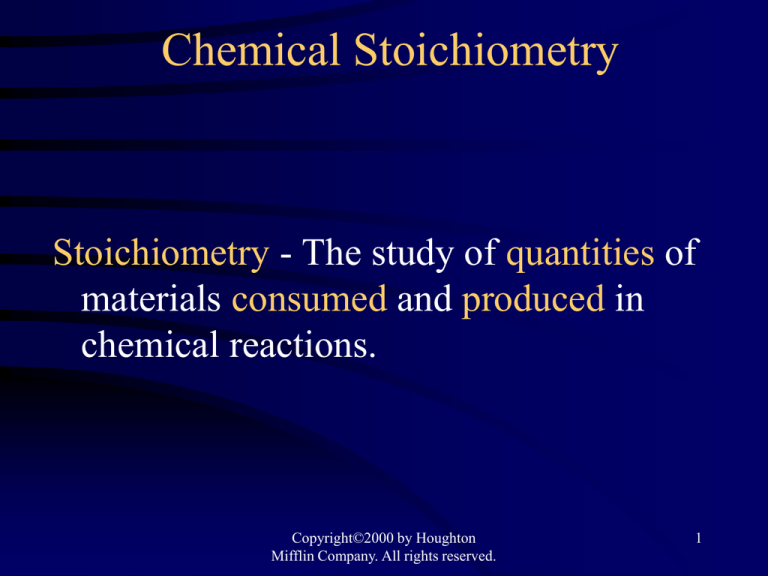
Chemical Stoichiometry
Stoichiometry - The study of quantities of
materials consumed and produced in
chemical reactions.
Copyright©2000 by Houghton
Mifflin Company. All rights reserved.
1
Atomic Masses
Elements occur in nature as mixtures of
isotopes
Carbon =
98.89% 12C
1.11% 13C
<0.01% 14C
Carbon atomic mass = 12.01 amu
Copyright©2000 by Houghton
Mifflin Company. All rights reserved.
2
The Mole
The number equal to the number of carbon
atoms in exactly 12 grams of pure 12C.
1 mole of anything = 6.022 1023 units of
that thing
Copyright©2000 by Houghton
Mifflin Company. All rights reserved.
3
Avogadro’s number
equals
23
6.022 10 units
Copyright©2000 by Houghton
Mifflin Company. All rights reserved.
4
Molar Mass
A substance’s molar mass (molecular
weight) is the mass in grams of one mole of
the compound.
CO2 = 44.01 grams per mole
Copyright©2000 by Houghton
Mifflin Company. All rights reserved.
5
Exercise
3.2
3.4
Molar Mass, molecular weight (correct formula),
formula weight – all the same, just a language
problem (“molecular implies covalent bonding
while “formula implies ionic bonding.) {It’s a
giant conspiracy designed to keep the uneducated
from ever understanding chemistry – kind of like
the scoring system in tennis.
3.7
6
Diatomics
The –gens
H, N, O, and halogens
Copyright©2000 by Houghton
Mifflin Company. All rights reserved.
7
Percent Composition
Mass percent of an element:
mass of element in compound
mass %
100%
mass of compound
For iron in iron (III) oxide, (Fe2O3)
111.69
mass % Fe
100% 69.94%
159.69
Copyright©2000 by Houghton
Mifflin Company. All rights reserved.
8
Exercise
3.10
Penicillin, the first of a now large number of
antibiotics (antibacterial agents), was
discovered accidentally by the Scottish
bacteriologist Alexander Fleming in 1928,
but he was never able to isolate it as a pure
compound. This and similar antibiotics have
saved millions of lives that might have been
lost to infections. Penicillin F has the
formula C14H20N2SO4. Compute the mass
9
percent of oxygen.
Formulas
molecular formula = (empirical formula)n
[n = integer]
molecular formula = C6H6 = (CH)6
empirical formula = CH
Copyright©2000 by Houghton
Mifflin Company. All rights reserved.
10
Empirical Formula Determination
1. Base calculation on 100 grams of
compound.
2. Determine moles of each element in 100
grams of compound.
3. Divide each value of moles by the smallest
of the values.
4. Multiply each number by an integer to
obtain all whole numbers.
Copyright©2000 by Houghton
Mifflin Company. All rights reserved.
11
Determining Empirical and Molecular Formulas I
Exercise 3.11
71.65%C1
24.27%C
4.07% H
The molar mass is known to be 98.96 g/mol.
Exercise 3.13
Caffeine, a stimulant found in coffee, tea, and
chocolate, contains 49.48% carbon, 5.15%
hydrogen, 28.87% nitrogen, and 16.49% oxygen
by mass and has a molar mass of
194.2 g/mol. Determine the molecular formula of
caffeine.
Copyright©2000 by Houghton
Mifflin Company. All rights reserved.
12
Chemical Equations
Chemical change involves a
reorganization of the atoms in one or
more substances.
Copyright©2000 by Houghton
Mifflin Company. All rights reserved.
13
Chemical Equation
A representation of a chemical reaction:
C2H5OH + 3O2 2CO2 + 3H2O
reactants
products
Copyright©2000 by Houghton
Mifflin Company. All rights reserved.
14
Chemical Equation
C2H5OH + 3O2 2CO2 + 3H2O
The equation is balanced.
1 mole of ethanol reacts with 3 moles of
oxygen
to produce
2 moles of carbon dioxide and 3 moles of
water
Copyright©2000 by Houghton
Mifflin Company. All rights reserved.
15
Balancing a Chemical Equation I
Exercise 3.14
When solid ammonium dichromate a vivid orange compound,
is ignited, a spectacular reaction occurs. Although the
reaction is actually somewhat more complex, let’s assume
here that the products are solid chromium(III) oxide,
nitrogen gas, and water vapor. Balance the equation for
this reaction.
Exercise 3.15
16
Solving a Stoichiometry Problem
1.
2.
3.
4.
Balance the equation.
Convert masses to moles.
Determine which reactant is limiting.
Use moles of limiting reactant and mole
ratios to find moles of desired product.
5. Convert from moles to grams.
Copyright©2000 by Houghton
Mifflin Company. All rights reserved.
17
Exercise 3.16
Solid lithium hydroxide is used in space
vehicles to remove exhaled carbon dioxide
from the living environment by forming
solid lithium carbonate and liquid water.
What mass of gaseous carbon dioxide can
be absorbed by 1.00 kg of lithium
hydroxide?
Copyright©2000 by Houghton
Mifflin Company. All rights reserved.
18
Exercise 3.17
Baking soda (NaHCO3) is often used as an antacid. It
neutralizes excess hydrochloric acid secreted
by the stomach:
NaHCO3(s) + HC1(aq) → NaC1(aq) + H2O(l) + CO2(aq)
Milk of magnesia, which is an aqueous suspension of
magnesium hydroxide, is also used as an antacid:
Mg(OH)2(s) + 2HC1(aq) → 2H2O(l) + MgC12(aq)
Which is the more effective antacid per gram, NaHCO3 or
Mg(OH)2 ?
.
19
Limiting Reactant
The limiting reactant is the reactant
that is consumed first, limiting the
amounts of products formed.
Copyright©2000 by Houghton
Mifflin Company. All rights reserved.
20
Exercise 3.18
Nitrogen gas can be prepared by passing
gaseous ammonia over solid copper(II)
oxide at high temperatures. The other
products of the reaction are solid copper and
water vapor. If a sample containing 18.1 g
of NH3 is reacted with 90.4 g of CuO,
which is the limiting reactant ? How many
grams of N2 will be formed?
Copyright©2000 by Houghton
Mifflin Company. All rights reserved.
21
Percent yield: The ratio of actual to
theoretical yield.
Actual Yield × 100% = Percent yield
Theoretical Yield
Copyright©2000 by Houghton
Mifflin Company. All rights reserved.
22
Exercise 3.19
Methanol (CH3OH), also called methyl alcohol, is the
simplest alcohol. It is used as a fuel in race cars and is a
potential replacement for gasoline. Methanol can be
manufactured by combination of gaseous carbon monoxide
and hydrogen. Suppose 68.5 kg CO(g) is reacted with 8.60
kg H2(g).
Calculate the theoretical yield of methanol. If 3.57 × 104 g
CH3OH is actually produced, what is the percent yield of
methanol ?
Copyright©2000 by Houghton
Mifflin Company. All rights reserved.
23

